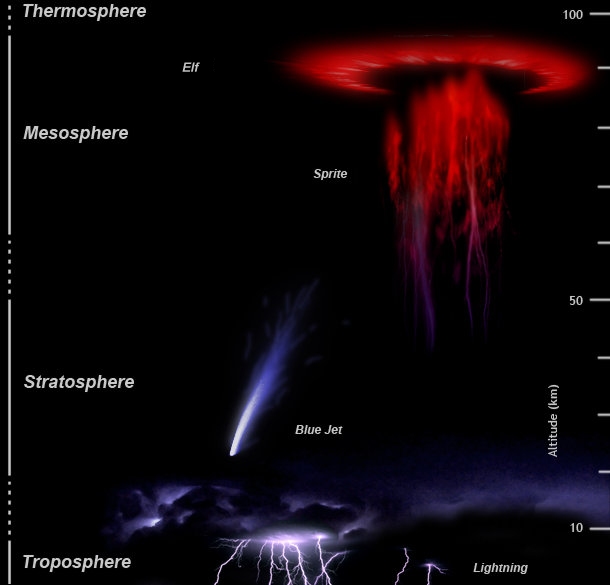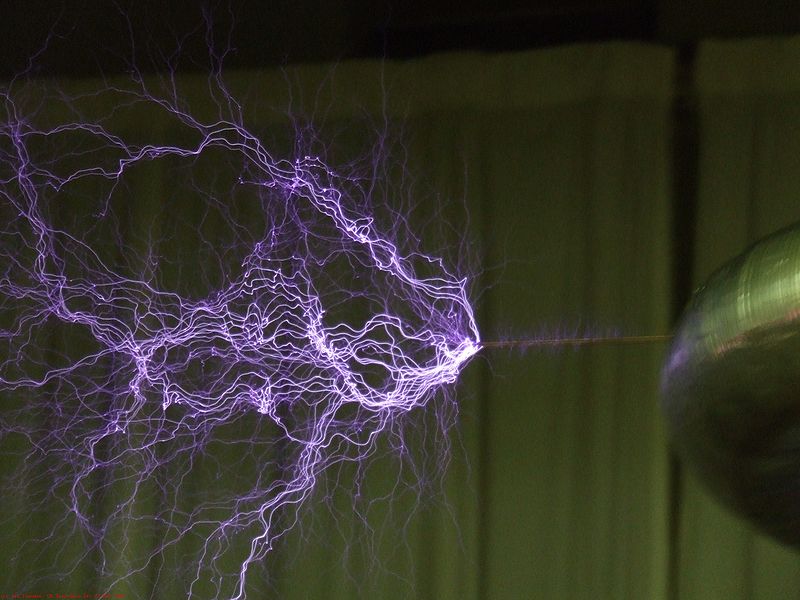https://en.wikipedia.org/wiki/Sprite_(lightning) wrote:
<<Sprites have been observed over North America, Central America, South America, Europe, Central Africa (Zaire), Australia,
the Sea of Japan and Asia and are believed to occur during most large thunderstorm systems.
In 2016, sprites were observed during Hurricane Matthew's passage through the Caribbean. [However,] the role of sprites in the tropical cyclones is presently unknown.
Sprites appear as luminous reddish-orange flashes. They often occur in clusters above the troposphere at an altitude range of 50–90 km. Sprites are cold plasma phenomena that lack the hot channel temperatures of tropospheric lightning, so they are more akin to fluorescent tube discharges than to lightning discharges. Sprites are associated with various other upper-atmospheric optical phenomena including blue jets and ELVES. Sprites or red sprites are large-scale electrical discharges that occur high above thunderstorm clouds, or cumulonimbus, giving rise to a quite varied range of visual shapes flickering in the night sky. They are usually triggered by the discharges of positive lightning between an underlying thundercloud and the ground.
Cloud-to-ground (CG) lightning is either positive or negative, as defined by the direction of the conventional electric current between cloud and ground. Most CG lightning is negative, meaning that a negative charge is transferred to ground and electrons travel downward along the lightning channel. The reverse happens in a positive CG flash, where electrons travel upward along the lightning channel. Positive lightning is less common than negative lightning, and on average makes up less than 5% of all lightning strikes.
There are six different mechanisms theorized to result in the formation of positive lightning:
- Vertical wind shear displacing the upper positive charge region of a thundercloud, exposing it to the ground below.
The loss of lower charge regions in the dissipating stage of a thunderstorm, leaving the primary positive charge region.
A complex arrangement of charge regions in a thundercloud, effectively resulting in an inverted dipole or inverted tripole in which the main negative charge region is above the main positive charge region instead of beneath it.
An unusually large lower positive charge region in the thundercloud.
Cutoff of an extended negative leader from its origin which creates a new bidirectional leader in which the positive end strikes the ground, commonly seen in anvil-crawler spider flashes.
The initiation of a downward positive branch from an IC lightning flash.
Positive lightning strikes tend to be much more intense than their negative counterparts. An average bolt of negative lightning carries an electric current of 30,000 amperes (30 kA), and transfers 15 coulombs of electric charge and 1 gigajoule of energy. Large bolts of positive lightning can carry up to 120 kA and 350 C. The average positive ground flash has roughly double the peak current of a typical negative flash, and can produce peak currents up to 400 kA and charges of several hundred coulombs. Furthermore, positive ground flashes with high peak currents are commonly followed by long continuing currents.
As a result of their greater power, positive lightning strikes are considerably more dangerous than negative strikes. Positive lightning produces both higher peak currents and longer continuing currents, making them capable of heating surfaces to much higher levels which increases the likelihood of a fire being ignited. The long distances positive lightning can propagate through clear air explains why they are known as "bolts from the blue", giving no warning to observers.
Despite the popular misconception that these are positive lightning strikes due to them seemingly originating from the positive charge region, observations have shown that these are in fact negative flashes. They begin as IC flashes within the cloud, the negative leader then exits the cloud from the positive charge region before propagating through clear air and striking the ground some distance away.
Positive lightning has also been shown to trigger the occurrence of upward lightning flashes from the tops of tall structures and is largely responsible for the initiation of sprites several tens of kilometers above ground level. Positive lightning tends to occur more frequently in winter storms, as with thundersnow, during intense tornadoes and in the dissipation stage of a thunderstorm. Huge quantities of extremely low frequency (ELF) and very low frequency (VLF) radio waves are also generated.>>
 Sprite Lightning at 100,000 Frames Per Second
Sprite Lightning at 100,000 Frames Per Second


